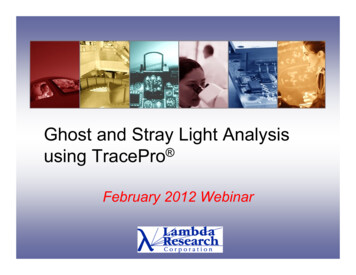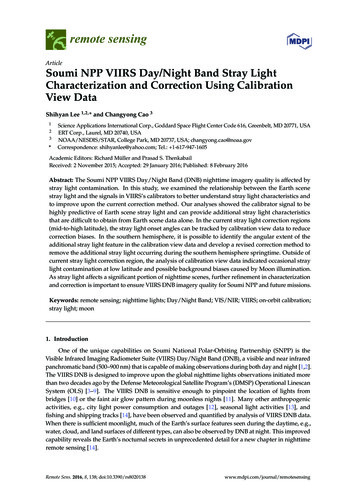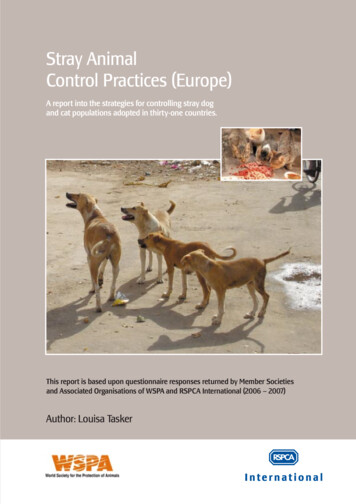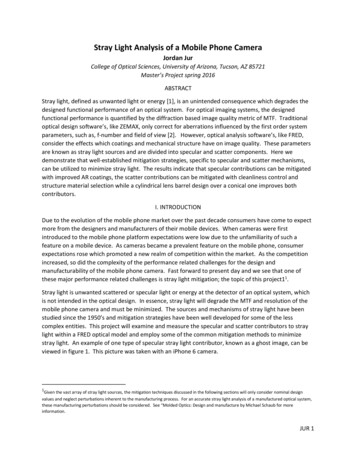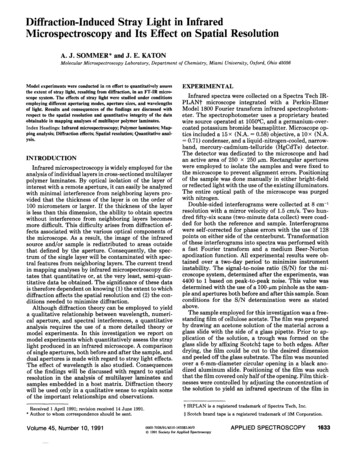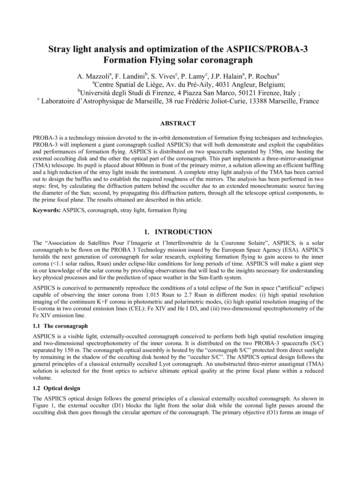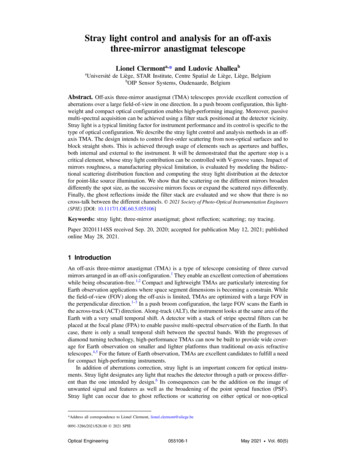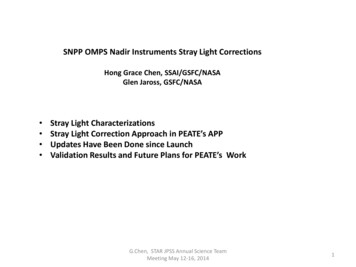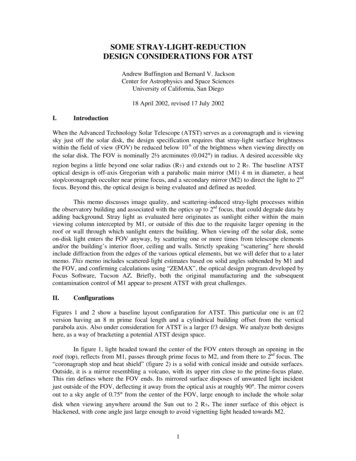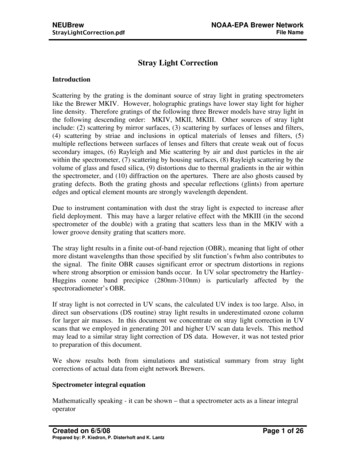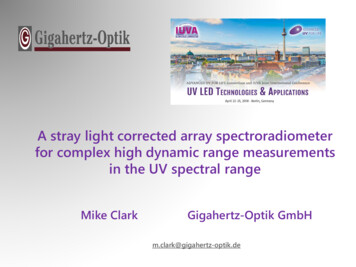
Transcription
A stray light corrected array spectroradiometerfor complex high dynamic range measurementsin the UV spectral rangeMike ClarkGigahertz-Optik GmbHm.clark@gigahertz-optik.de
Array spectroradiometersArray spectrometers – used extensively inspectroscopy and optical radiation applications Fast measurementsSolid stateCost effectiveFlexibility2
Array spectroradiometers – entrance opticsSpectroradiometer - instrument for measuring radiometric quantities innarrow wavelength intervals over a given spectral region. (CIE definition)Entrance optic determineswhat radiometric quantitycan be measured e.g. :-Cosine diffuserSpectral irradianceW/(m² nm)CalibrationstandardIntegrating sphereSpectral radiant fluxW/nmEntranceopticSpectrometerF.O.V. opticSpectral radiant intensityW/(sr nm)3
Array spectroradiometers - calibration30W D21000WFELTungsten halogen and deuteriumlamps commonly used – but both havetheir limitationsCalibration source needs to besuitable for required radiometricquantity and entrance optic4
What is Stray light?Spectral irradiance mW m-2 nm-1Stray light is signal that is detected during a spectroradiometermeasurement in addition to the real 450nm400nm350nm300nm250nm200nm10-4The amount of stray light in a measurement strongly depends onthe light source and the spectrometer itself.5
Stray light causesPossible causes of internal stray light:Scatter from the diffraction gratingReflections and scatter from 0th orderHigher orders of diffractionDouble diffractionScatter from imperfect mirrorsInter-reflections between opticalcomponents Diffuse reflections within housing Optically over-filling entrance aperture Fluorescence Array detector6
‘Out of Range’ stray lightEach pixel in an array detector is sensitiveto all wavelengths in the detector’s rangeBack-thinned CCDs can offergood efficiency in UV 200-400nmConventional detectortechnologies (Si-based) have highresponsivity well beyond UVResults in ‘Out of Range’ stray light7
Significance of stray light for UV measurementsCommon sources e.g. sunlight (*)relatively high proportion ofvisible NIR radiationBiological action spectrahave wide dynamic ranges1010,1Actinic 350(*) Note very sharp rising edge400Calibration factors inversely proportional to responsivityTherefore, stray light component increasingly significant in deep UV8
Double monochromatorsDouble monochromators often specified as reference instrumentsB.1.1 Double monochromator: Recommended instrumentThe measurement of a source for the purpose of hazard classification requires accuracy duringcalibration and testing. The detector’s broad spectral response and high spectral resolution required toprovide accurate weighting leads to stringent requirements for out-of-band stray light rejection. .The ratio of out-of-band energy to pass-band energy at 270 nm fortungsten or tungsten-halogen calibration lamps should be smaller than10-4. The double monochromator is the only instrument that provides theneeded selectivity, and it is recommended for hazard measurementsinvolving UV and visible radiation. It is recognized that monochromatorsystems introduce limitations in convenience and speed. Use of a singlemonochromator in the UV or visible spectrum should be used only ifcomparable results to that from a double monochromator can beobtained. .Two monochromatorsin series, first acts as apre-filter. Limited straylight enters secondmonochromator.Mechanical scanning.Single elementdetectors only (e.g.PMT)No array detectormeaningful at exit ofdouble.9
Stray light suppression in array spectroradiometersGood optical designe.g. use of optical simulation raytracing software.Diffraction gratinge.g. holographic grating cf. ruled gratingOptical component selectione.g. mirror surface qualityInstrument housing designe.g. materials used, size, shape10
Mathematical correctionsTuneable lasers (OPOs) enable spectrometers to be characterized at any wavelength.Line Spread Functions (LSF)form a signal distributionfunction (SDF) characterizationmatrix of the spectrometer.Wavelength OPO /nm430nm200nm200nmDetector signal /nm430nmLSF matrix representationLSF of spectroradiometer measured using an OPOThe SDF data and the measurement data from the light source undertest enable the use of mathematical correction methods according to(Zong et al., 2006) or (Nevas et al., 2012).Zong Y, Brown S W, Johnson B C, Lykke K R and Ohno Y 2006 Simplespectral stray light correction method for array spectroradiometersAppl. Opt. 45 1111-9Nevas S, Wübbeler G, Sperling A, Elster C and Teuber A 2012Simultaneous correction of bandpass and stray-light effects in arrayspectroradiometer data Metrologia 49 S4311
Stray light matrix correctionPossible to reduce stray light by between 1 and 2 orders of magnitudeMathematical stray lightcorrection applied to awhite LED measurement Mathematical correction must be performed for every measurementAn OPO is required in order to perform the measurements preciselySpectroradiometer must be stable (time and temperature) for SDF matrix to workSmall wavelength shift is very significant w.r.t. stray light matrix12
Limitations of mathematical correctionsOptimum stray light suppression requires the LSFs to be measuredover the entire spectral sensitivity range of the detectorHolographic grating 1800g/mm 230nm blazeUV optimised grating (e.g. 200 nm to400 nm) only permits a minor part ofthe stray light to be correctedBack-thinned CCDStray light beyond 400 nm (Outof Range, OoR) cannot becorrected with this method!13
Use of filtersUse of long-pass filter (e.g. SchottGG435) determines OoR stray lightduring calibration.But subsequent measurementslikely to have different stray lightLong-pass filter – Schott GG435Bandpass filters – Schott UGInterference bandpass filtersBandpass filters can significantly reduce potential for straylight – akin to first half of a double monochromatorPerfect bandpass filters not available (e.g. out of bandtransmission, narrow and low passband transmission)14
BTS2048-UV-S stray light corrected spectroradiometer1. Optical radiation2. Cosine diffuser3. Filter wheel(*)4. BiTec sensor5. Electrical connectors6. Microprocessor for dataprocessing and communication(*) BTS technologyBTS2048-UV-SA miniaturized filter wheel holds a set of upto 6 different optical bandpass and longpass filters.Optimized stray light-reduced spectraresult from the smart combination of submeasurements.Integration timeSpectral rangeOptical bandwidthPixel resolutionNumber of pixelsChipADCDynamic rangePeak wavelengthBand-pass correctionLinearityIntegral photodiode (SiC) CCD erviceand-support/knowledge-base/bts-technology/2 μs - 60 s(190 - 430) nm0.8 nm 0.13 nm/Pixel2048Back-thinned CCD chip, 1stage cooled16bit (25 ns instruction cycle time) 9 Magnitudes 0.05 nmmathematical onlinecompletely linearized chip 99.6%15
PTB characterization of BTS2048-UV-SDevice characterization undertaken by PTBe.g. wavelength accuracy, radiometric accuracy, linearity,stray light rejection, bandpass function, etc.Bandpass function around centroid λc for different wavelengthswith bandwidth (FWHM, dashed lines) indicated.16
BTS2048-UV-S-WP Solar irradiance measurementsMeasurement of solar radiation in UV-B is particularly challenging– conventionally the domain of double monochromatorsTherefore, a good quality test!Ozone Hole was first announced in apaper by British Antarctic Survey’s JoeFarman, Brian Gardiner and JonathanShanklin, which appeared in the journalNature in May 1985.Instrument specification requirementsdeveloped in 1990’s.Comparison of a solar measurement with BTS2048-UV-S-WP and adouble monochromator illustrates the high dynamic range of thestray light corrected array spectroradiometer17
TOC inter-comparison IzañaTotal Ozone Measurements Inter-comparison at Izaña Tenerife, Sep 12th – 30th, 2016Izaña Atmospheric Research Center in conjunction with World Radiation Center (PMOD-WRC)BTS2048-UV-S mounted on a solar trackerGround-based spectroradiometer measurements of direct solar UV irradiance can be used todetermine the Total Ozone Column (TOC) by applying the Beer-Lambert law in conjunction withthe known absorption characteristics of ozone over the 290-350nm wavelength range. Suitablemodelling is required to minimise the influences of other atmospheric attenuators [1].[1] Vaskuri, A., Kärhä, P., Egli, L., Gröbner, J., and Ikonen, E.: Monte Carlo method for determining uncertainty of total ozone derived fromdirect solar irradiance spectra: Application to Izaña results, Atmos. Meas. Tech. Discuss., https://doi.org/10.5194/amt-2017-40318
TOC inter-comparison measurement resultsThe measured spectra and integralvalues showed good agreement tothe results of the double monochromator based QASUME (*)reference system.The performance (stray lightsuppression, absolute radiometricprecision and wavelength precision)was proven by calculating the totalozone column from direct solarmeasurementsThe results showed deviationsof the TOC of less than 1.5 %to other well amt-2017-240QASUME - transportable referencespectroradiometer forQuality Assurance of SpectralUltraviolet Measurements in Europe19
UV LED measurementIs stray light correction needed for ‘simple’ routine measurements of UV LEDs?Optical bandwidthdifference only20
UV LED measurementThe need for stray light suppression varies depending on application.BTS2048-UV-SBTS2048-UV21
Proven UV performance - applicationsSolar measurements – excellent stray lightsuppression, dynamic range and linearity isabsolutely essential.Photobiological safety measurementsexcellent stray light suppression, dynamic rangeand linearity is absolutely essentiale.g. for IEC EN 62471 and 2006/25/ECHigh power UV measurements i.e. UV curing anddisinfection / water treatment - high dynamic rangeand linearity required as typical calibration sources havecomparably low spectral powerBTS2048-UV-S with fibrecoupling optionUV LED measurements – excellent referenceinstrument, highest accuracy, suitable inpresence of ‘external’ stray light (e.g. room light)22
ConclusionWith appropriate stray light suppression techniques,compact array spectroradiometers can match theperformance of traditional double monochromatorsmaking them suitable for many of the mostdemanding UV spectroradiometry applications.Their compactness and robustness offers newlevels of speed, convenience and flexibility.They are well suited for use as reference gradeinstruments as well as providing accuracy andreliability for more routine measurements.23
Thank you for yourinterest and attentionMike Clarkm.clark@gigahertz-optik.deAcknowledgements24
What is Stray light? Stray light is signal that is detected during a spectroradiometer measurement in addition to the real signal. The amount of stray light in a measurement strongly depends on the light source and the spectrometer itself. Real. Measured. 200nm. 250nm. 350nm 3 00nm. 400nm.
